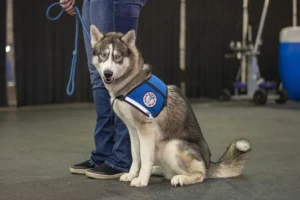There are a variety of hand signals people can use to train their dog at home. These signals are easy to learn and can be used to cue your dog to do a variety of things, such as sit, stay, come, and down.
Not all dogs respond well to these hand signals right away; some may take months of practice before they understand what each gesture means. If you seem to be struggling with your dog’s ability to understand these signals, there are a variety of training books and videos available online that can help.

What Are the Most Common Hand Signals For Dog Training?
One basic hand signal is the “stop” signal. This signal is simply raising your hand in the air, palm out, to indicate to your dog that he or she should stop what they are doing.
Another common hand signal is the “stay” signal. This signal is performed by placing your palm out and slowly lowering it towards the floor. This gesture tells your dog to stay in place until you give them further instruction.
The “come” signal is one of the most important signals to know. This signal is simply waving your hand in an upward motion, as if you were signaling a waiter to come over at a restaurant. Keep in mind that many dogs will not pay attention to this signal unless they are trained properly over time.
The “down” signal is used to tell your dog to lay down on his or her stomach. To perform this signal, place your palm facing downwards and then move it straight back towards yourself with some force.
What To Do When Training With Hand Signals?
Hand signals are signals used along with vocal commands to help dogs understand better. There are many different types of hand signals people use for dogs; some include sit, paw, come, down and stay. It’s important that dog owners know the positives outcome of each hand signal so their dogs can fully understand them.
When training a dog to do hand signals, choose hand signals that are easy for you and your dog to remember. A good way to make sure your dog remembers the signal is to teach her to touch her nose or paw at your hand as you give the cue. It’s also helpful if everyone in the family uses the same signals; otherwise, it will be confusing for your pooch and decrease their ability to respond quickly.
Always use positive reinforcement in the form of treats or praise. Avoid using negative reinforcement, such as yelling or slapping the dog’s nose. If the dog doesn’t understand what is being asked of her, stop giving the cue until they know it better. Remember to keep training sessions short and enjoyable for both you and your pet. Once the dog has learned all the signals, start using them with commands like “sit” and “stay.”
When To Call A Professional Dog Trainer
Although many people believe they can train their own pets, this is not always the case. It’s not because these individuals are bad pet owners; in fact, most of them love their pets very much and do all they can to provide for them. However, sometimes it helps to have an objective party outside the family unit involved in training your canine companion. Things like untrained behavior (barking, chewing) or simply problems you’re having with getting your dog to listen may be quickly resolved with the help of a professional dog trainer or animal behaviorist.
Situations calling for a professional dog trainer might include:
- You’re having trouble housebreaking your dog.
- Your dog barks excessively or constantly at other animals or people.
- He or she has a problem with jumping on people or furniture.
- You can’t get your dog to stop chewing on everything in sight.
- The animal is fearfully aggressive towards other animals or people, even family members.
- He or she suffers from separation anxiety and becomes destructive when left alone.
If you’re experiencing any of these issues (or others), Sit Now Stay Dog Training can help. Our dog trainers can not only offer solutions to these problems, but they can also provide training that will help create a better relationship between you and your pet.





